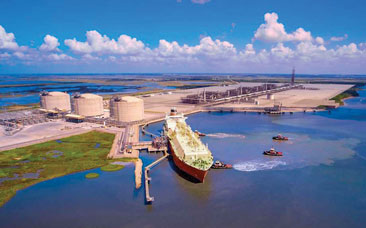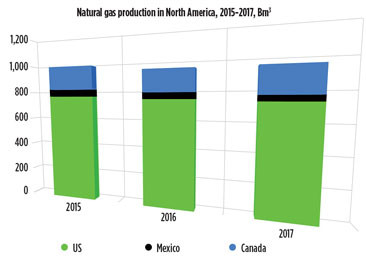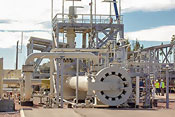Gas Processing News
Sempra receives FERC notice for Port Arthur LNG
 |
Sempra Energy received a notice of schedule from the US Federal Energy Regulatory Commission (FERC) that sets January 31, 2019 as the planned completion date of the final environmental impact statement for siting, construction and operation of the proposed Port Arthur LNG natural gas liquefaction export project in Jefferson County, Texas.
The FERC issued its notice for the proposed Port Arthur LNG project on August 31. The project is expected to include two gas liquefaction trains to enable the long-term sale of approximately 11 MMtpy of LNG; feed gas pretreatment facilities; NGL and refrigerant storage; up to three LNG storage tanks; two marine berths; and associated facilities.
The ultimate decision to construct the Port Arthur liquefaction project is contingent upon obtaining customer commitments and financing; reaching a definitive EPC contract; securing permits; and reaching FID.
Appalachia, Permian, Haynesville drive US gas growth
 |
Gross production of US natural gas has generally been increasing for more than a decade. This growth has been largely driven by production in the Appalachian Basin in the Northeast, the Permian Basin in western Texas and New Mexico, and the Haynesville Shale in Texas and Louisiana. These three regions collectively accounted for less than 15% of total US natural gas production in 2007, but now they make up nearly 50% of total production.
Production in these regions has increased in part because of new drilling and completion techniques, including longer well laterals that have increased well productivity. By contrast, the Gulf of Mexico’s share of total production, which was 12% in 2007, has fallen to approximately 3%. The share of production in the rest of the US has declined from 60% to 28%.
Growth in natural gas production in the Northeast has come mainly from the Marcellus and Utica shale plays in the Appalachian Basin, which collectively accounted for approximately 29% of total production in July 2018. Recent infrastructure buildout in the region has allowed natural gas to move out of the region and has reduced the prevailing discount to the national benchmark price at Henry Hub and to regional prices.
Natural gas production in the Permian Basin has also grown in recent years, largely in the form of associated gas accompanying the region’s rising crude oil production. Like the Appalachian Basin, natural gas in the Permian trades at lower prices relative to Henry Hub due to regional infrastructure constraints. New natural gas pipelines are planned or under construction that will help move natural gas out of the region, and several of them will expand LNG export capability.
Production in the Haynesville region has also increased. After decreasing from its peak in 2012, rising production in the Haynesville region since 2017 has been driven by improving initial production rates and increasing rig counts. Higher rig counts are likely a result of recovering crude oil prices, which have generally increased since early 2016. Together, the Haynesville and the Permian regions accounted for nearly 20% of total US natural gas production in 2017.
In contrast to the Appalachian, Permian and Haynesville regions, the Gulf of Mexico has accounted for an increasingly smaller portion of national production, which is a significant change from a decade ago. Older wells in the Gulf tend to be more natural gas-rich, and newer wells tend to be more oil-rich. These factors contributed to the overall decline in that region’s natural gas production.
INFRA and Greenway ink pact
Greenway Technologies Inc. and INFRA Technology LLC have entered into a non-exclusive memorandum of understanding (MU) agreement for the joint design, engineering and development of economical and transportable GTL plants, using a combination of the two companies’ proprietary technologies.
As the industry for small-scale GTL plants evolves and the technology becomes more readily available, companies have focused on only one or two of the necessary components to build and deliver a turnkey, profitable facility. INFRA is a leader in Fischer-Tropsch (F-T) reactor and catalyst design. Greenway has developed and patented a transportable, scalable and economic converter for synthesis gas generation needed to feed an F-T reactor, called the G-Reformer.
In addition to these necessary components, building GTL plants requires the leadership and financial discipline of an EPC to deliver against top-level contracts for on-time and on-budget build programs. Greenway has been working with Audubon Engineering for several years and named the company its EPC firm in 2018.
As INFRA and Greenway combine their capabilities, they will reduce the time to deploy plants capable of processing flared or vented gas. GTL systems from the companies can also be used to process coal and biomass assets, providing the ability to convert natural gas streams into useable products including diesel, gasoline and jet fuel.
Nord Stream 2 on track, despite sanctions
 |
The Nord Stream 2 pipeline to transport Russian gas to Germany is progressing on schedule, according to its operator, with European investors still committed to the project despite Western sanctions.
In July, the US government repeated a warning to Western firms invested in the 1,200-km (746-mi) pipeline that they were at risk of sanctions, saying that Russia is using the project to divide Europe. The pipeline will allow Russia to bypass Ukraine. Disputes between Russian gas firm Gazprom and Ukraine over gas prices and transit fees have led to several supply stoppages to Europe over the past decade.
Nord Stream 2 AG, which will double the existing Nord Stream 1 capacity from 55 Bm3/yr of gas, is owned by Gazprom, which is taking on half of the planned pipeline cost of €9.5 B ($11 B). The remainder of the CAPEX is divided between five European energy companies—Germany’s Uniper and Wintershall, Anglo-Dutch Royal Dutch Shell, France’s Engie and Austria’s OMV.
Gazprom and its European partners say the Nord Stream 2 project will help ensure energy security in the region as gas production falls in Europe. Pipe-laying in the Baltic Sea commenced in July.




Comments